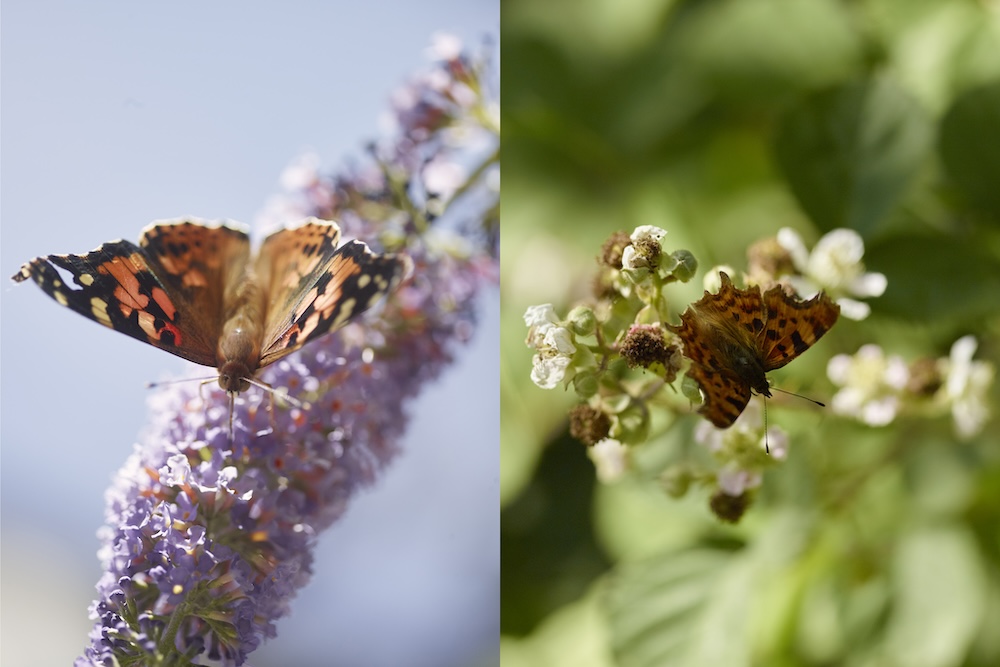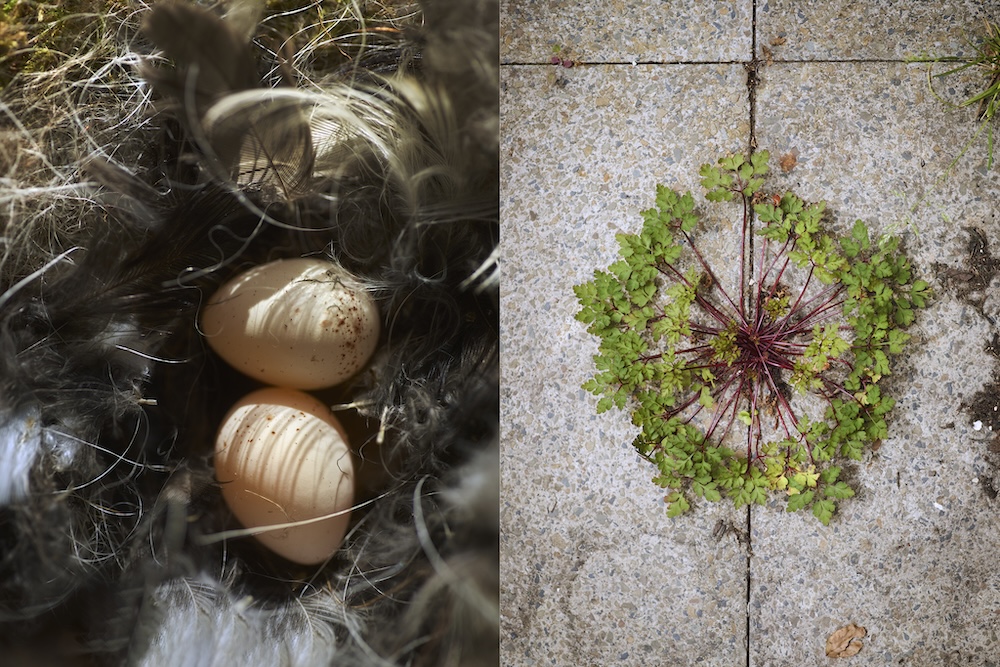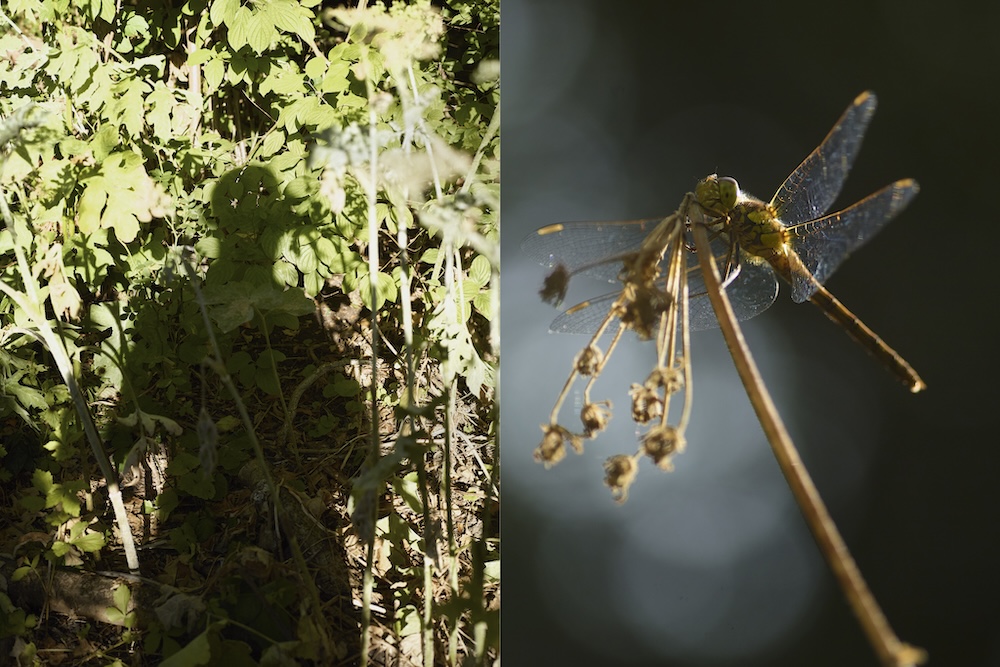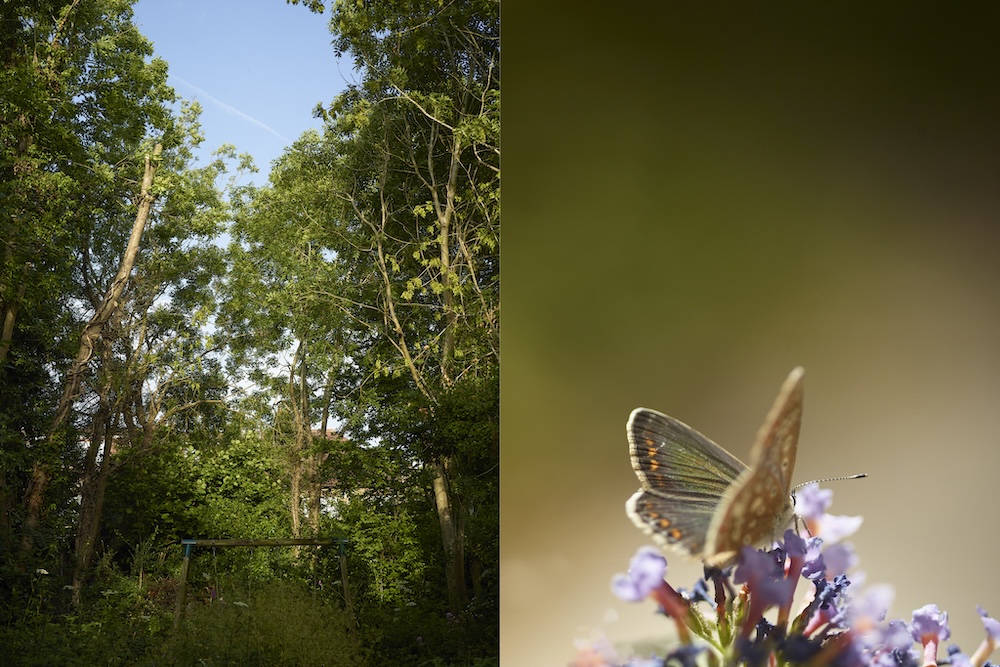Butterflies glow, flit, skank and chase through Mark Mattock‘s “feral’d” NW2 garden.

June, July
‘Youre tale anoyeth al this compaignye. Swich talkyng is nat worth a boterflye’
― Geoffrey Chaucer, The Canterbury Tales
A tiny delta-winged moth on the other side of kitchen window stares in at me from the unknown darkness beyond it, accusingly, impassively, with its disproportionately large alien compound eyes like the sunglasses of nightclub doormen. What have I done? So much passive aggression from such a diminutive soul. The kettle boils. I pour the hot water onto the lemon slices in the white china mug. Within minutes of sitting back down on the sofa and slipping back into television stupor the cat, who was slumbering on the rug near sliding glass door, suddenly explodes with such ferocity that I involuntarily do the same, stubbing big toe on the table, spilling lemon tea and shouting expletives as if others were in the room to convince that my reaction isn’t as embarrassing as it looked. The hissing, fizzing, fur bomb’s whole body gurning as if being electrocuted. A whole Mohican running full length of his spine, now an impossible yoga arch of pure fury. In the cat’s reflection fragments of another face staring back, just the other side of the glass. Clearly discernible are big tent-front triangular ears angled on the cat, the cat’s flat against his bristling nape. The cat tries smashing the face with a flurry of white-pawed punches. The fox cub shows the cat all its teeth and how wide it can open its mouth, the double glazing mutes any accompanying sound the cub might be making. Both then suddenly back off. The cat to under the sofa, the fox cub back into the dark. I go to the kitchen to get a cloth, the moth is still on the window.
As usual the vixen is sitting alert but peacefully in the bare space that I recently cleared of cow parsley, now gone to seed, just beyond the second raised bed. In a sun pool freshly exposed, released from night’s dark as the hard, straight-edged shadow of the rooftop recedes down the garden towards the patio like an ebbing tide. I now know she’s waiting for next door’s irritable Jack Russell to catch her scent. She yawns a jagged yawn, her jawlines like serrated dandelion leaves, much more “dandefox” than dandelion. Above her in the mature ash canopy a creche of dusty rasping juvenile starlings chase an adult. They propel through the tree tops as one, like a shoal of minnows chasing a flake of bread downstream as it stop-starts through the weed. A rusty mottled little pert brown bird pops from its hiding place deep in the boundary hedge, temporarily into the light, lands on the upright edge of the rusty bare skeletal mattress that the French beans will soon be climbing. A juvenile robin, no longer needing to be fed. No brick red and buff breast yet but unmistakably robin. I lost track of the robins after the cat ate the nest full of chicks in Ivy Tower. Just feet away the fox doesn’t even glance at it.

A door slides open; it’s almost as if I can hear the vixen’s odorant molecules rush past, enter and rattle against the sides of the ratty little dog’s nasal cavity, overwhelm its olfactory receptors, and the “ping” in its limited brain. Attack, kill. The instantly frenzied dog scuttles up its garden, barking maniacally, to the point opposite the calculative vixen waiting this side of the tangled ivy, bramble and jasmine boundary. Sometimes she just sits in amusement, this time she charges into the hedge snarling and yapping ferociously, biting at the vegetation inches in front of the now uncontrollable dog. Its owner charges after it, “stop it, stop it, stop it”; to the fox, which I’m not sure she can see, “go way, go way, go way.” Pure comical chaos. She fetches the hose, turns on the water and hoses the frenetic dog, hoses it back towards the house. The vixen trots off, satisfied, slips back into the thorn spinny in the far corner. The fox clearly gets something from winding up the dog, I’ve seen it practically every day for the last few weeks. Karma.
In the redolent hot-day ambience, time climbs up the foxglove spikes, a ring of drooling, bee-sucking-and-blowing bells a day. The whole garden bombus scene is now dominated by one species — white-tailed bumblebees — and numbers are climbing with the temperature. In the confetti of little fierce blue alkanet flowers, a red butt bee that doesn’t look quite right. The narcissus fly merodon equestris (its larva feed on the bulbs of narcissi) is another bee mimic and new to the garden. Or my ever-increasing attention. The thickly matted strangle bush (honeysuckle) is a cascade of hydra-headed blooms of exploding petals and spitting anthers: white, yellow, copper red. A juvenile blackcap picks the tiny insects from within them whilst ducking bumblebees. Another nice surprise. Where was the nest?
Diamonds of shattered glass glint in the ash of the teenager’s fire pit. Tea-stained, heart-shaped confetti rots on the patio slabs under the feral rose, some of the petals crudely glued together with slicks of glistening slime. Merlin the bird call ID app lists a spectacularly un-synchronised choir of seven singers in five minutes and proves again that I don’t listen as attentively as I thought I did. It hears the faint distant peeps of a coal tit and is deaf to the high-pitched whine-cum-vibration of the bees in the crumpled poppies. In the worked flowers anthers drop en mass and collect at the bottom of the bowl of petals before they too drop off and wither in the baking sun, like weird pink opium-flavoured rizlas. Merlin falls for the same mistake as me, misidentifying some short lone phrases of the robin as a blackcap. Goldfinches are collecting fibres from the same wool cladding on the raised beds as all the other small bird nesters have been doing all spring. An adult robin is sunning on the radiant sheet metal roof of the beehive looking as if it’s been dropped — still alive, startled and panting its last breath — from a great height by a clumsy passing hawk. Wings and feathers spread to maximise radio therapeutic photon penetration. A jay suddenly pounces, unannounced, from nowhere onto the bare strip of fence top with a sort of “here’s johnny” intensity: raised crestlike hair that can’t be wetted down and glaring psychotic eyes of manic indifference. Small birds all uptight. Multiple almost ultra sonic warning signals. The nest hunter then silently flaps over to Ivy Tower, then up into the ash crowns at the back, peering down with considerable concentration. It then drops down onto the tit box, gives it a thorough inspection, just to be sure. The cock wren suddenly lets off, not in scolding alarm, “you murdered my family,” but piercingly as in “I’m still here.”

All the green is darkening, hardening; becoming anaemic. The neon glow of blood-green chlorophyll in backlit leaves and blades slowly draining daily. Brilliant snow-white saucers of hogweed umbels in slanting angles, left and right, jet away into the distance over the brittle rust cow parsley it replaced like hawthorn follows the sloe. An illusion of speed and motion in a scene dead still and oppressively hot. Sporadic jolts among them where unseen blue tit juveniles flit from under one umbel to another harvesting aphids. Sporadic jolts among the buttercups suddenly pulled down by the weight of landing bees I also can’t quite see. Vixen snoozes just visible in a curl of bliss in her bivvy of dark, soft, bramble-filtered light behind the pallet wedged to hold it all up. The dog fox passed through yesterday without greeting. She sporadically half opens eyelids to check me behind the kitchen window. Ears flicking annoying diptera, seemingly deaf to screeching wren but pin-point alert to every tap, rustle and distant bark. Ivy Tower now festooned, with spiralling constellations of jasmine soaking the mini garden thermals with its warm heady aroma. Out front privet petals collect like salted snow slush replacing the fractal flakes of elder florets of earlier in the month. Under the thorns at the back the garlic leaves lie all around like banana peels thrown from car windows in a well-visited roadside lay-by. Everything shallow-rooted, limp and sagging like the thirsty fox’s tongue. Gravid large cabbage white females glow with halos in the blinding bright, fluttering, foot tasting, desperately wanting the giant prickly palmate courgette leaves to be cabbages. The giant golden courgette flowers look carnivorous, waiting to snatch any butterfly coming close enough. Every day more butterflies. Unprecedented.
I released the first of the red admirals this morning, reared from the eggs collected from the nettle bed. The kitchen window left wide open since. Minutes later I think the butterfly has flown back in, but I see no red as it circles, head-butting the ceiling. It’s Mormo Maura, the old lady moth. I put the Sunday dressed chicken into the pre-heated oven feeling I’m being watched. I am. On the baked hard path to the far right corner sits the hieroglyphic vision of a young Anubis, the Egyptian jackal god of funerary practices in the form of a teen fox cub. Sleek, slender, nimble; big head with disproportionately large velvet pointy smoke tipped ears slightly tilted, inquisitive and wary; cute, cocky, curious. I feel it had been watching me for a long time, unnoticed, matching all the tone and colour of the desiccated vegetation around it. Umbers and siennas, raw and burnt. We just stare at each other through the heat haze in which ever more white butterflies glow, flit, skank and chase in our peripheral vision.
Every day the garden looks more and more like a segment of Umbrian wayside and a postcard from the long hot summer of ’76. Butterflies swirling in pure drought nostalgia. The umbellifer stands like scaled-down visions of parched outback eucalyptus forests; dying, diseased, desiccated. Everything bleached, leached, rinsed, crisped, oxidised. The hogweed looks poisoned, doused in a white toxic talc, like thinned chalk of baked summer village football pitches. But on the white doily plateaus continuous frenetic landing and leaving at light speed: hoverflies, more narcissus flies, micro wasps, parasitic wasps and miscellaneous diptera. A common darter dragon has been picking some off like a sparrowhawk swooping on a bird table. And of those swirling butterflies — any one moment during the hottest hours — up to a dozen whites: large, small, green veined; three sparring speckled woods, two commas laying eggs in the nettles, a red admiral doing the same, a gatekeeper (the first of the summer), a meadow brown, second brood holly blues. A painted lady, whose mother possibly started her journey north from the Atlas Mountains in Morocco at the very beginning of spring, and probably the one I released yesterday, raised from an egg I watched her battered mother lay on a thistle back in may, sat like a fridge magnet on one of the new drooping nectar-drenched buddelia cones. Salaam sister.

Every cool-lull-before-the-oppressive-heat morning the alarm clock, in the form of an intricately feathered ping pong ball, goes off ear piercingly without fail, around 4.30 am. If the wren fails to drive me from the bed, the raucous rough rose neck horde of ash-seed-plucking parakeets will, bitching loudly as they snip off the bunches of seed and manipulate like a bunch of grapes with their dexterous zygodactyl feet: two talons front, two back.
Two smoke-stained and deathly grey wood pigeon juveniles that look like a pair of awkward phoenixes risen from the fire pit balancing in the restless canopy surrounded by the chandeliers of ash mast now glowing almost fluorescent in the early morning sun of another scorching day. A young squirrel bounces along the fence top up to the dirty white pom poms of the climbing roses threaded throughout Sparrow Bush. It deftly picks one, sits back on its haunches and frenziedly plucks it petal by petal; in a kind of stressed out “she loves me, she loves me not”. By mid-morning the rays once again penetrate the exhausted umbellifer forest to resume baking the cracked, brick-dry earth from which, now, hardcore summer flora triumphantly towers: purple hard-headed knapweed, ragwort glowing in its own nimbus of impossible yellow; white froth knots of meadow sweet, vintage pink mallow, and lilac blue field scabious, once used to treat scabies and the sores of bubonic plague. Suckers of cherry shoot skywards from the immense web of roots of the tree felled in early spring like insurgent survivors of a forgotten crop of a previous season. Bramble shoots weave along the ground through the hogweed stems, ominously creep across the patio towards the house, the tips searching for suitable substrate to form new rootstock. The bushes they sneak out from heavily laden with promise of blackberry crumble and clafoutis. Sun-bled courgette and garlic mustard leaves once again wilted like sweat-soaked tissue. The vegetation squeezing from the gaps between the patio slabs like hedgerows marking the boundaries of mini square fields.

On a butterfly bush spike what I was sure was a second brood holly blue butterfly surprises me by becoming a female common blue when the auto-focus zips to pin-sharp. A new species for the garden. The following day I net what I think is the common blue now sitting wings clenched on a ox-eye seed head, in the cool morning stillness, and place her in a makeshift flight cage over the large pot of bird’s foot trefoil in the hope of getting a few eggs. But on close examination she is clearly he and he is a velvet fresh brown argus butterfly. Yet another new species. The undersides of both species are very similar. It’s getting a bit surreal, they’re not really urban garden insects. But by now, at this point in the year, I’m not actually that surprised. It reflects what I, and other butterfly “heads”, have been experiencing — a phenomenal, unprecedented butterfly (and other insects) year.
Incredible numbers including some of the rarest species appearing almost miraculously at sites where they were long thought gone or just suspected. It follows a genuinely apocalyptic year for butterflies. It follows a series of articles in mainstream media earlier in the year of “insectageddon”, the apocalyptic global insect population collapse scientists are screaming warnings about. Yet here, in the most nature-depleted countries in the world, an almost unfathomable resurgence. But, and a big but, all these species are appearing two weeks earlier than they used to, are “supposed” to.
What is it all saying? What can be gleaned from this? How will it pan out? Will this dry hot period continue and eventually burst the bubble of false promise, or hope?
Faint shimmering pulses of iridescence in the ephemeral sun pools between the bamboo canes, exposed by the restless ash canopy above. At the centre of each perfect little sticky orb web, a tiny golden eight-legged, eight-eyed, poison-fanged bullseye in the form of a female garden spiderling. Vigilantly, patiently, feeling the changing tensions made by the indiscernible zephyrs circulating in the surrounding evening air via the tiny hooks at the tip of each leg each clamped to a radiating spoke. Tiny fishers with their multiple lines, awaiting the tugs and vibration of sudden struggle; of the summer insects on which they will incrementally fatten.
Crowds of virgin princesses with capes of glistening single-use wings in a mass breakout out from the tunnels and chambers under the heavy pavement slabs. Joined by diminutive one-chance only drones dying — literally — to make them queens; a muggy ant day.
*
Mark Mattock. Artist. Photographer. Publisher. Rabbit Fighter. @the_rabbit_fighters_club